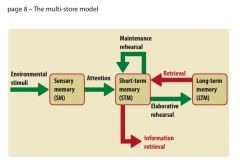![]()
![]()
![]()
Use LEFT and RIGHT arrow keys to navigate between flashcards;
Use UP and DOWN arrow keys to flip the card;
H to show hint;
A reads text to speech;
31 Cards in this Set
- Front
- Back
|
Name the stages of information processing. |
Input, Encoding, Storage, Retrieval, Output
(I Exit Shops Riding Ostriches) |
|
|
Explain the first stage of information processing. |
Information enters memory from the environment through the senses. |
|
|
Explain the second stage of information processing. |
Putting information into a format that the memory system can recognise. |
|
|
Explain the 'Storage' process. |
Info is filed away to be used at a later date in a memory store we can later access. |
|
|
Explain the 'Retrieval' stage. |
Search the memory store for information and sometimes we cannot find it because we lost it: forgotten. |
|
|
Explain the final stage of memory storage. |
Output is when we release the information we have retrieved by saying something or writing something down; but it can also just be bought back to our memory front like remembering song lyrics. |
|
|
What is an accessibility problem? |
Not being able to access information because we cannot get to it in our memory, even though we know it's there. This can include the 'tip of the tongue' phenomenon. |
|
|
What is an availability problem? |
Not being able to retrieve information because it isn't there to start with. |
|
|
What is the Core Theory of Memory? |
Multi-store model. |
|
|
Give an overview of the MS Model of Memory. |
The memory system is made up of distinct stores that are affected by time and space. The two main stores are Short and Long term. |
|
|
Recite the model. |

|
|
|
What does the first store hold in the MSMM? |
Sensory information. That's why it's called the Sensory Store. Only lasts for a few seconds. If we don't pay attention to it, it decays. |
|
|
What percentage of sensory info goes to the STM? |
Only about 1% |
|
|
Why do things get displaced? |
Because the memory store gets over filled and has no space. |
|
|
How do we get information into the LTM? |
Maintenance rehearsal: repeat or practice it. Rehearse information for about 30 seconds before transfer to LTM. |
|
|
What is the capacity and duration of the LTM? |
Unlimited. |
|
|
What is the capacity of the STM? |
7+/-2 chunks. |
|
|
What is a chunk? |
One piece or a group of related pieces of data. |
|
|
What is the duration of the STM measured in? |
Seconds. |
|
|
The duration of the STM? |
10-20 seconds. |
|
|
Name the 3 crisicisms of the Multi Store model. |
Ignores individual differences. Over simplifies the STM and LTM. Over emphasises the role of rehearsal. |
|
|
What is the alternative theory of memory? |
Levels of processing. |
|
|
Outline the Levels of Processing theory. |
We remember things by shallow and deep processing. Shallow process is not thinking deeply about meaning whereas deep is details and meanings. |
|
|
Who's study was the Core study? |
Terry 2005. |
|
|
Outline the procedure of Terry's study. |
39 students watched a series of 15, 10 month old adverts (maximum 30 seconds long) using repeated measures design. They were first asked to recall the adverts immediately after seeing them, then viewed them again in a different order and had to recall them after a delay in which they completed a 3 minute written task. |
|
|
Results of Terry's study? |
Serial position affect. In immediate recollection conditions, the primary and recency effect meant that there was good recollection of the first and last ones but not middle. After the delay, there was primacy (because of time to rehearse) but no recency because the written task had stopped rehearsal time for that. |
|
|
Conclusion of Terry's study? |
Order was what mattered in memory, not meaning. Hence shown by primary and recency. |
|
|
Name 3 limitations of Terry's study. |
Laboratory experiments lack ecological validity. Lack construct validity. Demand characteristics. |
|
|
Explain the construct validity issue in Terry's study. |
Takes a narrow measure: there's more to memory than remembering commercials. Especially when ads were all 30secs and 10months old. |
|
|
Explain demand characteristics in Terry's study. |
After the written task, they may have realised Terry was trying to measure memory and may have purposely changed their effort and results. |
|
|
How can research into memory be applied? |
Use of cues to prompt return of lost info. Mind maps help to revise because they reflect the way memory is organised. Use of imagery gives more meaning: deep processing. |

